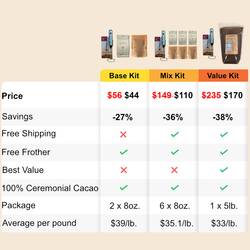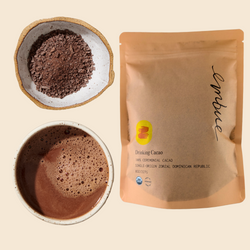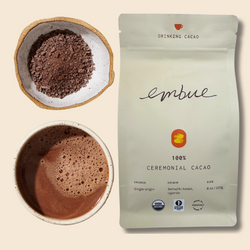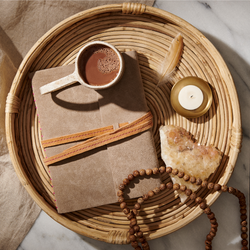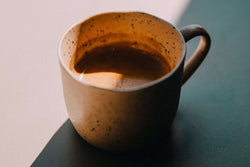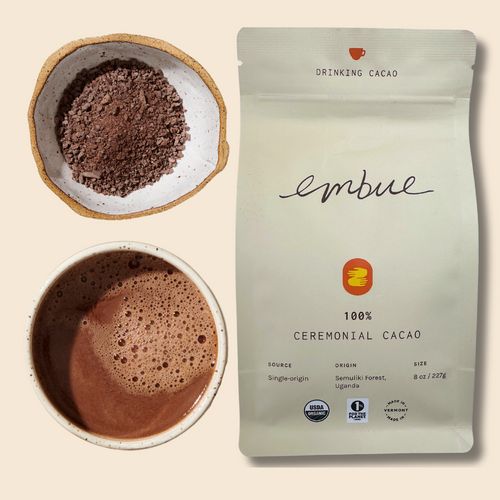All about raw cacao!
There is a lot of hype these days about raw cacao, including folks in the cacao ceremony world who say it's vital to use raw cacao in ceremony. This blog post is meant to clear up some of the confusion for those of you wanting the real low-down on cacao.
Generally speaking there is a school of thought that believes that raw food is inherently better than food heated above a certain temperature. This belief has spilled over into the cacao world, from chocolate making to pure cacao in bean or paste form. The basic story goes that raw cacao is more pure, unadulterated and contains higher levels of various compounds that are beneficial to health, which would make it more potent for ceremony.
This story is lacking for several reasons. The first reason is that there probably isn't any actual raw cacao available. Remember that cacao in its raw form, fresh from the pod, is bitter and unpalatable, so needs to go through various processes to make it useable to humans. I don't know of a single supplier who can guarantee that through these processes of fermenting (think huge piles of fermenting cacao in the tropics) and sun-drying (think concrete pad in the tropic sun), the temperature doesn't go above raw levels. It would require very precise instruments to constantly monitor and would likely result in incomplete fermentation or drying. These steps are necessary and would need to be done in modern industrial facilities to have the conditions and equipment necessary to guarantee raw temperatures are not exceeded. Fermentation and sun-drying are vital steps in producing high quality cacao for ceremony. In its actual raw form, straight from the tree, cacao is unpalatable and contains anti-nutrients such as tannins and phytic acid. Fermentation is the beginning of removing these substances and chemically transforming cacao.
The second reason is that higher temperatures during roasting are a sanitary procedure. Again, think of fermenting piles of cacao in the tropics that are hot, wet and dark. The growth of unwanted bacteria or mold is highly likely in these conditions. Even if you were to be able keep temperatures below raw levels during fermentation, you would want further processes that kill off these pathogens. The heat of roasting the cacao after it has been sun-dried will do this. Usually, roasting cacao brings the temperature up above 300 degrees Fahrenheit which is sufficient for sanitation purposes.
Roasting cacao has two other benefits. The first is the maillard reaction, which occurs at certain higher temperatures. This reaction fundamentally changes the cacao and gives us the flavor we know of as chocolate. Unroasted cacao will not taste like chocolate that we know. The second reason is that the husk on the cacao bean will be removed, and the roasting process make this much easier. Cacao has a husk or skin, much like an almond, and this needs to be removed. After roasting, it easily cracks off and can be winnowed away.
The third reason that story is often lacking has to do with marketing. There are many brands of cacao related products, from chocolate to cocoa powder, that claim to be raw. Often what they mean is that it’s pure cacao and that there isn’t anything else added or removed. This is playing on people’s perception as raw is associated with healthier, even though the product itself is unlikely to have been maintained at raw temperatures. Again, the facilities required to make this a guarantee are very costly and non-existent as far as we're aware. Raw is used more as a marketing strategy than an actual reference to specific processes it has been through and guarantees around those steps.
The last thing to address in relation to raw cacao is the nutrient content, a point often cited as favoring raw cacao. I have yet to come across a comprehensive study that compares the same cacao in raw form and after roasting. Without this, we can’t really make any claims about which is healthier or more potent. In raw form, cacao contains anti-nutrients such as phytic acid, as well as bitter tannins. Heat and proper fermentation are ways to remove these.
Anti-oxidants are one of the compounds that are much touted in cacao and specifically in raw cacao. Yet we don’t have data that gives us a clear comparison between raw and roasted. At the same time, standard testing of cocoa powder, which is much further de-natured that ceremonial cacao, has an ORAC value of 80,000 units per 100 grams and it's estimated that we need 8-11,000 unit/day. So, we could easily get that daily dose through cacao without the risk of using raw cacao. The raw camp usually just relies on the assumption that more is better but doesn’t have much to back that up.
All of that being said, it doesn’t mean we should process cacao without consideration for how hot or what types of things we do to it. High quality cacao paste is whole, pure cacao, without anything added to it. It can be roasted at moderate temperatures and not go through any further processing, as would cocoa powder or chocolate. We don’t need the additives in chocolate or the dutching process that separates cacao butter from the solids with chemicals.
The last thing to note is that all historical references I've seen about cacao and its use are that it's consumed after fermenting and roasting - never raw. I think there is value in a couple thousand years of experience working with a plant, rather than a vague idea that raw is always better. Certainly, there are foods that are better consumed raw. Cacao however, is not one of them.
